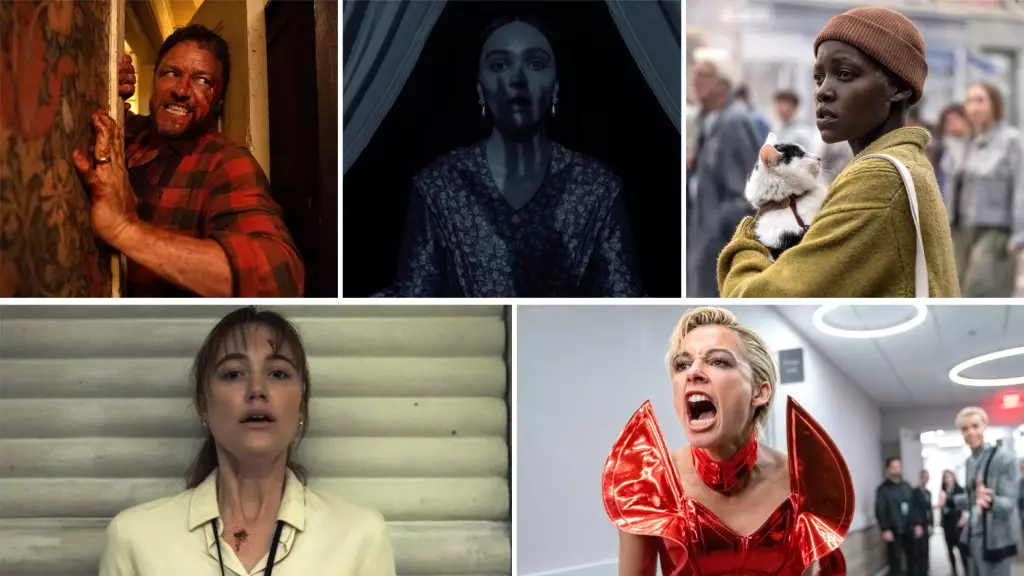As the cinematic world of 2024 unfolds, it becomes apparent that the tides of success are shifting—particularly within the horror genre. Deadline’s Most Valuable Blockbuster tournament highlights not just the overwhelming revenues from traditional box office sales but also the broader spectrum of profitability that encompasses streaming revenues and ancillary sales. In a time where traditional Hollywood paradigms are being upended, films are increasingly judged by their long-term profitability rather than the immediate returns of their opening weekends. This article explores several standout films that epitomize this trend, unearthing the strategies that have led these projects to phenomenal financial success.
The Mighty Return of the Horror Film
The resurgence of horror in 2024 underscores a remarkable strategy employed by studios to maximize profitability while appealing to a diverse audience. At the forefront of this revival is *A Quiet Place: Day One* from Paramount, which achieved an impressive net profit of $83.6 million. The film’s prequel status alone did not dissuade audience interest; rather, it bolstered anticipation. Directed by Michael Sarnoski and featuring new faces like Lupita Nyong’o, this film resonates with the franchise’s core strengths—tension, atmosphere, and a compelling storyline. Notably, the film’s opening weekend grossed $52.2 million, surpassing its predecessors in an unexpected triumph that indicates the franchise’s sustained popularity and the reliability of horror as a profitable genre.
What sets *A Quiet Place: Day One* apart is not just the financial success but its ability to breathe new life into an established franchise. The marketing employed clear communication of the franchise’s continuity while allowing for fresh narratives to emerge. It’s illustrative of a wider trend where studios recognize the importance of building franchises that deliver sustained engagement with audiences—proof that consistent quality can yield remarkable rewards at the box office.
Subverting Expectations: The Success of *Nosferatu* and *Smile 2*
Turning to unexpected hits, *Nosferatu* from Focus Features has made waves in a genre where period horror often falters. With a net profit of $70 million, this reimagining of a classic tale of Dracula saw its strong performance ignited by savvy marketing strategies. The film’s promotion skillfully blended traditional horror elements with a contemporary flare, cleverly teasing audiences without revealing key details until the film’s release. The tagline, “He is coming!” resonated deeply, generating significant buzz and marking it as Focus Features’ second-highest grossing film of all time, behind *Downton Abbey*.
On another note, the *Smile* franchise has successfully pivoted from its original streaming release to become a box office powerhouse with *Smile 2*, which netted $55.4 million. The film’s methodology employed an innovative marketing campaign that integrated the film’s narrative elements with real-world engagement. By using the character of pop star Skye Riley to create a dual storyline, the film effectively tapped into the cultural zeitgeist, thereby drawing in both horror fans and pop music enthusiasts alike.
Highlighting these successes reflects a growing understanding that horror films, often dismissed as niche, actually have the potential to create extensive outreach through strategic marketing and storytelling that transcends traditional demographics.
The Blumhouse Model: Innovation in Low-Budget Horror
Blumhouse Productions continues to redefine what it means to succeed in the horror genre with their film *Speak No Evil*, which, despite a modest box office opening of $11.2 million, managed to deliver a staggering net profit of $50 million. This success can be attributed to the studio’s unique business model that maintains low initial budgets while maximizing backend revenue through ancillary markets. By revising their approach to film-making, Blumhouse proves that creative storytelling paired with financial prudence can yield considerable returns—this methodology is essential in an industry often riddled with costly flops.
Furthermore, the strategic release of *Longlegs* by Neon, which grossed $22.4 million from a remarkably low marketing budget, demonstrates that creativity in marketing can turn the simplest ideas into box office gold. The avant-garde approach of hiding key elements from audiences until the film’s release keeps viewers intrigued and engaged, illustrating that in today’s market, the mystery often fuels desire.
Streaming Giants and Future Opportunities
While this year has seen traditional studios reaping the benefits of horror hits, the landscape also hints at a looming evolution where streaming giants like Apple and Amazon are inextricably linked to the industry’s future success. Their embrace of theatrical releases highlights a shift that could redefine profitability. However, their exclusion from reports like Deadline’s indicates a data gap that industry analysts must dissect to fully understand the implications of these business models.
Ultimately, as we dissect the box office successes of 2024, it becomes evident that the horror genre has not only secured its place as a reliable source of profit but has also established itself as a crucible for innovation—both in storytelling and market strategy. The future promises a battlefield where organizations that adapt to these changing tides will undoubtedly come out on top, thus paving the way for a new era in cinematic storytelling.
